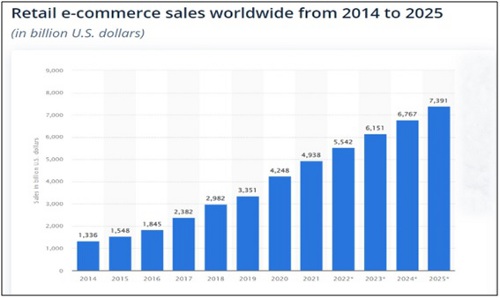eCommerce is one of the fastest growing and most dynamic industries at present. Research indicates that eCommerce sales are set to reach approximately $7300 billion by 2025.
Businesses have to match that pace of growth or risk missing out on substantial revenue. However, among other aspects, the key to thriving in online retail lies in impeccable product data. As businesses navigate the constantly transforming arena of eCommerce, the quality of product data will be the linchpin to unlock your business potential. Let’s explore why that’s the case.
Understanding product data in eCommerce
It is the digital representation of the products that businesses offer to their customers, playing a pivotal role in shaping the customer’s online shopping experience. It is the digital dossier of a product, offering a detailed profile that includes various attributes, characteristics, and features. This data is vital for customers who cannot physically inspect or interact with products before purchasing, making it the foundation of their decision-making process.
At its core, product data includes:
- Product description: These provide comprehensive insights into the product’s attributes, uses, advantages, and other particulars. A well-composed product description not only educates but also captivates potential buyers.
- Images: High-quality images are essential for showcasing the product from various angles and viewpoints. Visual appeal can significantly influence a customer’s decision to make a purchase.
- Pricing: Clear and accurate pricing information is critical, as discrepancies can lead to customer dissatisfaction and cart abandonment.
- Specifications: Technical details, such as dimensions, materials, and compatibility, help customers determine if the product meets their needs.
- Availability: Real-time stock information ensures customers are not misled about product availability.
Challenges and complexities of managing product data in eCommerce
Managing product data in the eCommerce environment is a complex task. In fact, according to a study, 54% of businesses find data quality maintenance as one of the most significant data management challenges.
Here are some of the common challenges and complexities of managing product data:
- Data accuracy: Ensuring that product data is accurate and up-to-date is a constant challenge. Any inaccuracies can lead to customer frustration and lost sales.
- Data completeness: Missing or incomplete data can leave customers with unanswered questions and hinder the shopping process.
- Data consistency: Consistency across product listings is crucial for branding and customer trust. Inconsistent data can lead to confusion.
- Data governance: Establishing and enforcing policies to maintain data quality and integrity can be complex, especially for businesses with vast product catalogs.
- Data integration: Integrating product data from various sources, such as suppliers, manufacturers, and internal databases, can be a technical challenge.
- Data scalability: As an eCommerce business grows, the volume and complexity of product data can increase exponentially, requiring robust systems and processes to manage it effectively.
What is bad data in the eCommerce business?
Bad product data can manifest in various ways, with some of the most common issues including inaccuracies, incompleteness, and inconsistency.
● Inaccuracies
Inaccurate product data can range from incorrect pricing and availability information to misleading product descriptions. For instance, a product may be listed at a lower price than its actual cost due to a data entry error, leading to customer disappointment and potential financial losses.
● Incompleteness
Incomplete product data, such as missing product dimensions, materials, or warranty information can create confusion among customers and force them to abandon their purchase.
● Inconsistency
Inconsistent product data across different channels or product listings can confuse customers. For instance, a product’s name, image, or specifications may vary between the website, mobile app, and social media, causing customer distrust and decreased brand credibility.
What are the consequences of bad data on your eCommerce business?
1) Customer impact
A. How bad product data leads to customer dissatisfaction
- Frustration and wasted time: When critical information, such as product specifications, materials, or sizing details, is missing, customers may have to search for this information elsewhere or contact customer support for clarification. This extra effort can lead to annoyance.
- Negative reviews and word-of-mouth: Dissatisfied customers share their experiences, damaging your business’s reputation.
- Trust erosion: When customers experience discrepancies between what was promised and what was received, they may become skeptical of your business’s credibility.
B. How inaccurate or incomplete product information affects purchasing decisions
- Hesitation: It leaves customers uncertain about whether a product meets their needs. This uncertainty can lead to hesitation and procrastination, as customers may be willing to commit to a purchase if they clearly understand what they are buying.
- Abandoned carts: When customers encounter surprises during the checkout process, such as pricing discrepancies or out-of-stock items, they are more likely to abandon their shopping carts.
- Increased returns: Customers who receive products that do not match the descriptions are more likely to initiate returns, which can be costly and logistically challenging for you to manage.
2) SEO and visibility
A. Impact of poor product data on search engine rankings and visibility
- Lower ranking potential: Inaccurate descriptions or wrong pricing can reduce your website’s ranking possibility. When search engines encounter data that doesn’t align with user expectations, they may prioritize other websites that offer more reliable information.
- Keyword relevance: When data aligns differently from the keywords potential customers use, the website is less likely to appear in relevant search results.
- Duplicate content concerns: Inconsistent or duplicate product data across the website can lead to duplicate content concerns. It can impact ranking as search engines may struggle to determine which version of the content to display.
B. How incomplete or incorrect data can harm your SEO efforts
- Ineffective metadata: Metadata, including title tags and meta descriptions, relies on accurate and complete product data. Insufficient data limits the ability to create compelling metadata, affecting click-through rates.
- Product schema markup: Accurate product data is essential for proper product schema markup. When data is incomplete or incorrect, it can lead to errors in presenting rich search results.
- Crawl efficiency: Poor-quality data can confuse web crawlers, which can impact the efficiency of indexing. While it doesn’t result in a penalty, it can affect how effectively search engines index and display your content.
3) Email bounce rates
A. Sending marketing emails to incorrect or outdated addresses
- Wasted resources: You’re wasting your resources, including time and effort, by sending emails to addresses that don’t exist or are no longer in use.
- Damaged reputation: Consistently sending emails to incorrect addresses can harm your brand reputation. Customers might perceive your emails as spam, which negatively affects your credibility.
- Reduced engagement: With inaccurate email addresses, your marketing messages aren’t reaching the intended audience. You’re missing valuable opportunities to engage with potential customers and retain existing ones.
- Lower conversion rates: If your email campaigns are sent to incorrect or outdated addresses, your conversion rates will likely decline. Customers who would have purchased or engaged with your content might be lost.
B. Impact on email deliverability and marketing campaign effectiveness
- Email deliverability: A high bounce rate can negatively impact your email deliverability, which means your emails are more likely to end up in spam folders. Internet service providers (ISPs) and email service providers (ESPs) monitor bounce rates as a signal of sender reputation and email quality.
- Spam triggers: Consistent bouncing can trigger spam filters, causing even legitimate emails to be marked as spam. This can harm your ability to reach your customers’ inboxes.
- Wasted marketing budget: Sending emails to invalid addresses consumes your email marketing budget, offering little to no return on investment.
- Reduced marketing effectiveness: Ultimately, an increased email bounce rate can reduce the effectiveness of your email marketing campaigns, leading to missed sales opportunities, reduced customer engagement, and potentially impacting your overall revenue.
Real-life examples of businesses affected by poor product data
1) Walmart
The Ledgewood Walmart faced a $1,800 fine after a concerned shopper reported incorrect unit prices for items. Despite notifying store management, the issue remained unresolved, prompting a Division of Consumer Affairs inspection and subsequent fines for 36 violations. This case underscores the importance of accurate unit pricing for consumers.
2) Amazon
Amazon experienced a high-profile incident when a technical glitch caused inaccurate pricing data for thousands of products. For example, some items were listed for just a few dollars, leading to a surge in orders. When Amazon attempted to cancel these orders, it faced backlash from frustrated customers.
What can you do to retain the quality of your product data (and how)?
A. Tips for maintaining high-quality product data
- Data standardization: Establish clear data standards and guidelines for product information. Ensure consistency in how data is collected, stored, and presented.
- Data cleansing: Implement processes to identify and remove duplicate, outdated, or irrelevant product data. Regularly clean and update your database to ensure it remains accurate and up-to-date.
- User-generated content: Encourage user-generated content, such as reviews and ratings, to supplement product information. This not only enhances data quality but also builds trust with customers.
- Customer feedback loop: Create a feedback loop with customers to report errors or inaccuracies in product data. This can be done through customer service channels or integrated feedback mechanisms.
- Implement data governance: Establish a data governance framework that assigns responsibilities for quality and ensures adherence to data standards.
- Data enrichment: Invest in data enrichment services or software to enhance your product data with additional information, such as images, user reviews, and relevant keywords.
B. Ways to implement the strategies
- Tools: Utilize data validation and cleansing tools to automate identifying and rectifying data errors. These tools can help maintain data accuracy and consistency, saving time and reducing manual efforts.
- Outsourcing: Consider outsourcing data management and quality control to specialized firms with experience in eCommerce product data entry services. This gives you access to experts who seamlessly handle data cleansing and validation on your behalf, ensuring data accuracy without diverting in-house resources.
- In-house experts: Build an in-house team with expertise in data quality control. Experts can develop and implement data standards, conduct regular audits, and ensure your product data remains accurate and up-to-date.
Are you ready to take the leap?
As we’ve explored the challenges and complexities of managing product data, the dire consequences of insufficient data, and real-life examples that underscore its impact, it’s evident that success hinges on data accuracy, completeness, and consistency.
So, are you prepared to invest in data excellence? Are you ready to harness the power of accurate product data to enhance your customers’ experiences, elevate your brand, and, ultimately, secure your place? The future awaits—seize it with data-driven confidence.



